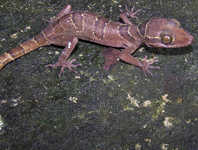Abstract
A new genus of the marine Stilbonematinae (Nematoda, Desmodoridae) is described from the Pacific coast of the United States of America. The worms inhabit the sulfidic sediment among the roots of the surfgrass Phyllospadix sp. in the rocky intertidal. The ectosymbiotic coat is of a new type for Stilbonematinae. It consists of rod-shaped bacteria pointed at both poles densely attached with one pole to the host cuticle. This is the first report of this symbiotic nematode subfamily from the US West Coast.
References
Boaden, P.J.S. (1977) Thiobiotic facts and fancies (aspects of the distribution and evolution of anaerobic meiofauna). Mikrofauna des Meeresbodens, 61, 45–63.
de Jesus-Navarrete, A. (2007) Littoral free living nematode fauna of Socorro Island, Colima, Mexico. Hidrobiológica, 17 (1), 61–66.
Farris, R.A. & Hooge, M.D. (1998) A sulfide system biotope associated with a high energy beach. American Association for the Advancement of Science (AAAS) Annual Meeting. American Association for the Advancement of Science (AAAS), Philadelphia, Pennsylvania. [poster presentation]
Fenchel, T.M. & Riedl, R.J. (1970) The Sulfide System. A new biotic community underneath the oxidized layer of marine sandy bottoms. Marine Biology, 7, 255–263.
https://doi.org/10.1007/BF00367496
Fleeger, J.W., Chandler, G.T., Fitzhugh, G.R. & Phillips, F.E. (1984) Effects of Tidal Currents on Meiofauna Densities in Vegetated Salt Marsh Sediments. Marine Ecology-Progress Series, 19, 49–53.
https://doi.org/10.3354/meps019049
Gerlach, S.A. (1963) Freilebende Meeresnematoden von den Malediven II. Kieler Meeresforschungen, 19, 67–103.
Greeff, R. (1869) Untersuchungen über einige merkwürdige Thiergruppen des Arthropoden- und Wurm-Typus. Archiv für Naturgeschichte, 35, 71–121.
Hopper, B.E. & Cefalu, C. (1973) Free-living marine nematodes from Biscayne Bay, Florida V. Stilbonematinae: Contributions to the taxonomy and morphology of the genus Eubostrichus Greeff and related genera. Transactions of the American Microscopical Society, 92 (4), 578–591.
https://doi.org/10.2307/3225268
Ott, J. (1967) Vertikalverteilung von Nematoden in Beständen nordadriatischer Sargassaceen. Helgoländer wissenschaftliche Meeresuntersuchungen, 15, 412–428.
https://doi.org/10.1007/BF01618638
Ott, J. (1997) A new symbiotic marine nematode; Adelphos rolandi gen.n. sp.n. (Stilbonematinae) from the Caribbean Sea. Annalen des Naturhistorischen Museums in Wien, 101B, 423–435.
Ott, J., Bright, M. & Bulgheresi, S. (2004) Symbioses between marine nematodes and sulphur-oxidizing chemoautotrophic bacteria. Symbiosis, 36, 102–126.
Scharhauser, F., Zimmermann, J., Ott, J.A., Leisch, N. & Gruber-Vodicka, H.R. (2020) Morphology of obligate ectosymbionts reveals Paralaxus gen. nov.: A new circumtropical genus of marine stilbonematine nematodes. Zoologica Scripta, 49, 379–394.
https://doi.org/10.1111/zsc.12399
Schindelin, J., Arganda-Carreras, I., Frise, E., Kaynig, V., Longair, Mark., Pietzsch, T., Preibisch, S., Rueden, C., Saalfeld, S., Schmid, B., Tinevez, J.-Y., White, D. J., Hartenstein, V., Eliceiri, Kevin., Tomancak, P. & Cordana, A. (2012) Fiji: an open-source platform for biological-image analysis. Nature methods, 9 (7), 676–682. [PMID 22743772]
https://doi.org/10.1038/nmeth.2019
Sterrer, W. & Soerensen, M. (2006) Chirognathia dracula gen. et spec. nov. (Gnathostomulida) from the west coast of North America. Marine Biology Research, 2, 296–302.
https://doi.org/10.1080/17451000600895013
Zuiderveld, K. (1994) s.n. In: Contrast limited adaptive histogram equalization. Graphics gems IV. Academic Press Professional, Inc., San Diego, California, pp. 474–485.
https://doi.org/10.1016/B978-0-12-336156-1.50061-6


